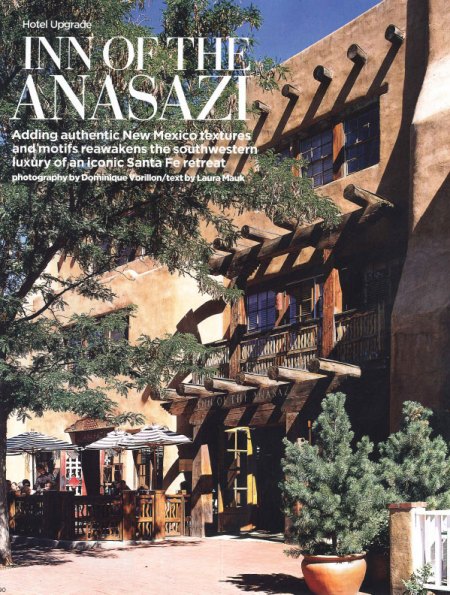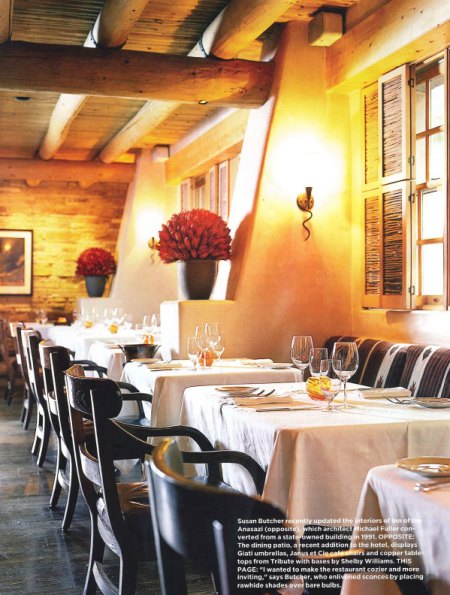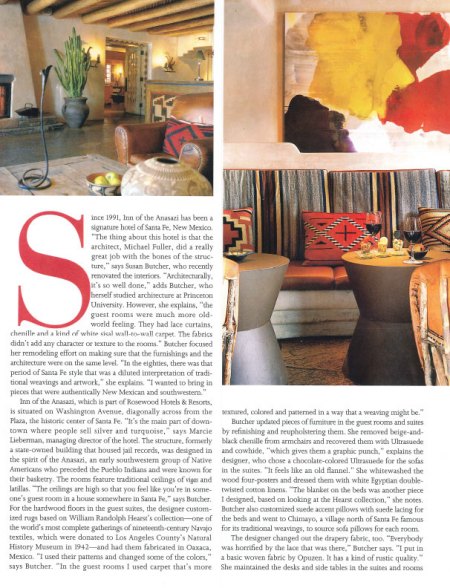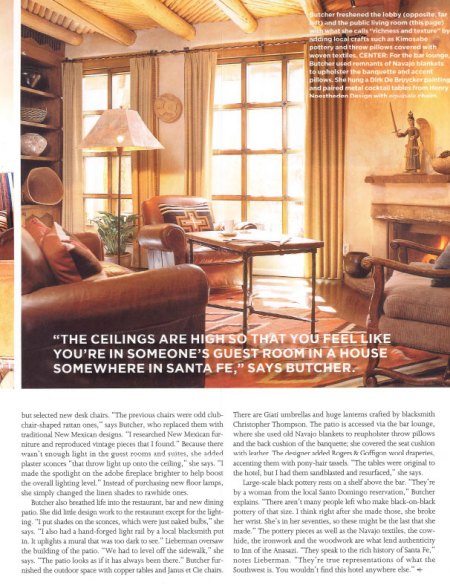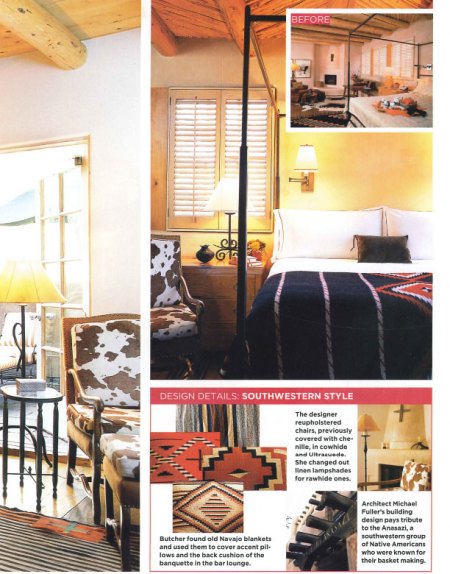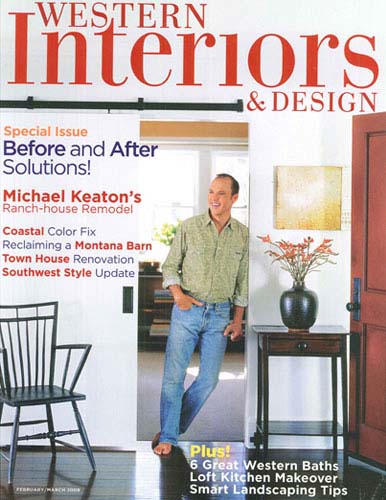 WESTERN INTERIORS | SPRING 2008
WESTERN INTERIORS | SPRING 2008
Hotel Upgrade
Inn at the Anasazi
Adding authentic New Mexico textures and motifs reawakens the southwest luxury of an iconic Sante Fe retreat
Since 1991, Inn of the Anasazi has been a signature hotel of Santa Fe, New Mexico. “The thing about this hotel is that the architect, Michael Fuller, did a really great job with the bones of the structure,” says Susan Butcher, who recently renovated the interiors. “Architecturally, it’s so well done,” adds Butcher, who herself studied architecture at Princeton University. However, she explains, “the guest rooms were much more oldworld feeling. They had lace curtains, chenille and a kind of white sisal wall-to-wall carpet. The fabrics didn’t add any character or texture to the rooms.” Butcher focused her remodeling effort on making sure that the furnishings and the architecture were on tl1e same level. “In the eighties, there was that period of Santa Fe style that was a diluted interpretation of traditional weavings and artwork,” she explains. “I wanted to bring in pieces that were authentically New Mexican and southwestern.”
Inn of the Anasazi, which is part of Rosewood Hotels & Resorts, is situated on Washington Avenue, diagonally across from the Plaza, the historic center of Santa Fe. “It’s the main part of downtown where people sell silver and turquoise,” says Marcie Lieberman, managing director of the hotel. The structure, formerly a state-owned building that housed jail records, was designed in the spirit of the Anasazi, an early southwestern group of Native Americans who preceded the Pueblo Indians and were known for their basketry. The rooms feature traditional ceilings of vigas and latillas. “The ceilings are high so that you feel like you’re in someone’s guest room in a house somewhere in Santa Fe,” says Butcher. For the hardwood floors in the guest suites, the designer customized rugs based on William Randolph Hearst’s collection-one of the world’s most complete gatherings of nineteentl1-century Navajo textiles, which were donated to Los Angeles County’s Natural History Museum in 1942-and had them fabricated in Oaxaca, Mexico. “I used their patterns and changed some of the colors,” says Butcher. “In the guest rooms I used carpet that’s more textured, colored and patterned in a way that a weaving might be.”
Butcher updated pieces of furniture in tl1e guest rooms and suites by refinishing and reupholstering them. She removed beige-andblack chenille from armchairs and recovered tl1em witl1 Ultrasuede and cowhide, “which gives them a graphic punch,” explains the designer, who chose a chocolate-colored Ultrasuede for the sofas in the suites. “It feels like an old flannel.” She whitewashed the wood four-posters and dressed them with white Egyptian doubletwisted cotton linens. “The blanket on the beds was another piece I designed, based on looking at the Hearst collection,” she notes. Butcher also customized suede accent pillows with suede lacing for the beds and went to Chima yo, a village north of Santa Fe famous for its traditional weavings, to source sofa pillows for each room.
The designer changed out the drapery fabric, too. “Everybody was horrified by the lace that was there,” Butcher says. “I put in a basic woven fabric by Opuzen. It has a kind of rustic quality.” She maintained the desks and side tables in the suites and rooms but selected new desk chairs. “The previous chairs were odd clubchair-shaped rattan ones,” says Butcher, who replaced them with traditional New Mexican designs. “I researched New Mexican furniture and reproduced vintage pieces that I found.” Because there wasn’t enough light in the guest rooms and suites, she added plaster sconces “that throw light up onto the ceiling,” she says. “I made the spotlight on the adobe fireplace brighter to help boost the overall lighting level.” Instead of purchasing new floor lamps, she simply changed the linen shades to rawhide ones.
Butcher also breathed life into the restaurant, bar and new dining patio. She did little design work to the restaurant except for the lighting. “I put shades on the sconces, which were just naked bulbs,” she says. “I also had a hand-forged light rail by a local blacksmith put in. It uplights a mural that was too dark to see.” Lieberman oversaw the building of the patio. “We had to level off the sidewalk,” she says. “The patio looks as if it has always been there.” Butcher furnished the outdoor space with copper tables and Janus et Cie chairs.
There are Giati umbrellas and huge lanterns crafted by blacksmith Christopher Thompson. The patio is accessed via the bar lounge, where she used old Navajo blankets to reupholster throw pillows and the back cushion of the banquette; she covered the seat cushion witl1 leather. The designer added Rogers & Goffigon wool draperies, accenting them with pony-hair tassels. “The tables were original to the hotel, but I had them sandblasted and resurfaced,” she says.
Large-scale black pottery rests on a shelf above the bar. “They’re by a woman from the local Santo Domingo reservation,” Butcher explains. “There aren’t many people left who make black-on-black pottery of that size. I think right after she made those, she broke her wrist. She’s in her seventies, so these might be the last that she made.” The pottery pieces as well as the Navajo textiles, the cowhide, the ironwork and the woodwork are what lend authenticity to Inn of tl1e Anasazi. “They speak to the rich history of Santa Fe,” notes Lieberman. “They’re true representations of what the Southwest is. You wouldn’t find this hotel anywhere else.” +t-

